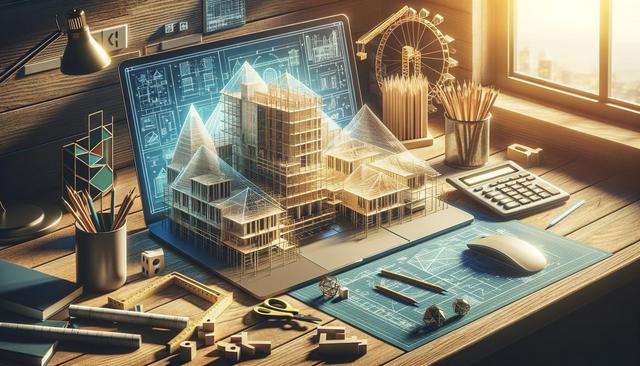
3D Building Design Software
Understanding the Role of Construction Software in Modern Projects
In today’s construction industry, software solutions are no longer optional—they are essential for managing complexity, improving accuracy, and enhancing collaboration across teams. Construction software encompasses a wide range of digital tools designed to support various aspects of the building process, from initial planning to final delivery. Among these tools, 3D building design software plays a particularly influential role. By enabling professionals to create detailed, data-rich models, this type of software allows for better visualization, clash detection, and design validation before actual construction begins.
These technologies are particularly beneficial in large-scale projects involving multiple stakeholders, including architects, engineers, and project managers. The integration of 3D modeling into construction software platforms has led to more efficient workflows and reduced errors during execution. Rather than relying solely on 2D blueprints, professionals can now interact with dynamic models that reflect real-world dimensions and construction constraints, ultimately leading to more informed decisions and better project outcomes.
Key Features of 3D Building Design Software
3D building design software offers a variety of features tailored to meet the demands of modern construction projects. These features not only enhance the precision of architectural designs but also facilitate better communication among project teams. Some of the most valuable features include:
- Real-time rendering and visualization
- Clash detection to identify design conflicts early
- Automated documentation and report generation
- Integration with Building Information Modeling (BIM) systems
- Collaboration tools for multi-user access and feedback
These capabilities allow teams to anticipate potential issues, make corrections before construction starts, and maintain alignment across various phases of the project. The software’s ability to simulate real-world conditions also helps in assessing structural integrity, energy efficiency, and material requirements, providing a holistic view of the building before a single brick is laid.
Benefits for Different Stakeholders in Construction
Adopting construction software, particularly those with 3D design capabilities, brings measurable benefits to all parties involved in a construction project. For architects, the software simplifies the design process and enhances creativity by offering flexible modeling environments. Engineers gain access to precise data that improve structural analysis and planning. Project managers benefit from improved scheduling, resource allocation, and cost estimation.
Some of the key advantages for stakeholders include:
- Minimized rework through accurate design coordination
- Faster project approvals with detailed visualizations
- Reduced project timelines and costs
- Enhanced documentation and compliance tracking
These benefits not only improve individual productivity but also contribute to the overall success of construction projects by reducing delays and enhancing quality control.
Challenges and Considerations in Software Implementation
While the advantages of construction software are clear, implementing these tools effectively requires careful planning. One of the primary challenges is the learning curve associated with advanced 3D design platforms. Training staff, adapting existing workflows, and ensuring compatibility with other systems can be resource-intensive. Cost is another factor, as high-quality software often involves significant upfront investment, along with ongoing licensing and maintenance fees.
To overcome these obstacles, firms should consider the following:
- Investing in staff training and continuous professional development
- Choosing software that integrates well with existing tools
- Evaluating long-term return on investment
- Starting with pilot projects to test software capabilities
By addressing these considerations early on, construction companies can maximize the value of their software investments and ensure smoother transitions from traditional methods to digital workflows.
Future Trends in Construction Software
The future of construction software is shaped by emerging technologies such as artificial intelligence (AI), cloud computing, and augmented reality (AR). These innovations are enhancing the capabilities of 3D building design software by introducing predictive analytics, real-time collaboration, and immersive visualization. AI algorithms, for example, can analyze design options and suggest modifications to improve efficiency or sustainability. Cloud-based platforms enable seamless access to project data from any location, facilitating better coordination across geographically dispersed teams.
Upcoming trends to watch include:
- Integration of smart construction materials with software analytics
- Real-time site monitoring through IoT devices
- Use of AR/VR for immersive design reviews and client presentations
- Automation of repetitive design tasks through machine learning
These developments are set to redefine how construction projects are planned and executed, making the industry more agile, data-driven, and client-focused.
Conclusion: Embracing Digital Tools for Building Success
For construction professionals aiming to stay competitive and deliver higher-value projects, embracing construction software—especially platforms that support 3D building design—is a strategic move. These tools offer a significant upgrade from traditional methods by improving design accuracy, enhancing collaboration, and reducing costly errors. However, to unlock their full potential, companies must invest in training, choose suitable platforms, and align their processes with digital workflows.
As the industry continues to evolve, those who adopt and adapt to these technologies will be well-positioned to lead in innovation, efficiency, and client satisfaction. Whether you are an architect, engineer, or project manager, tapping into the power of modern construction software can pave the way for smarter, more successful building projects.